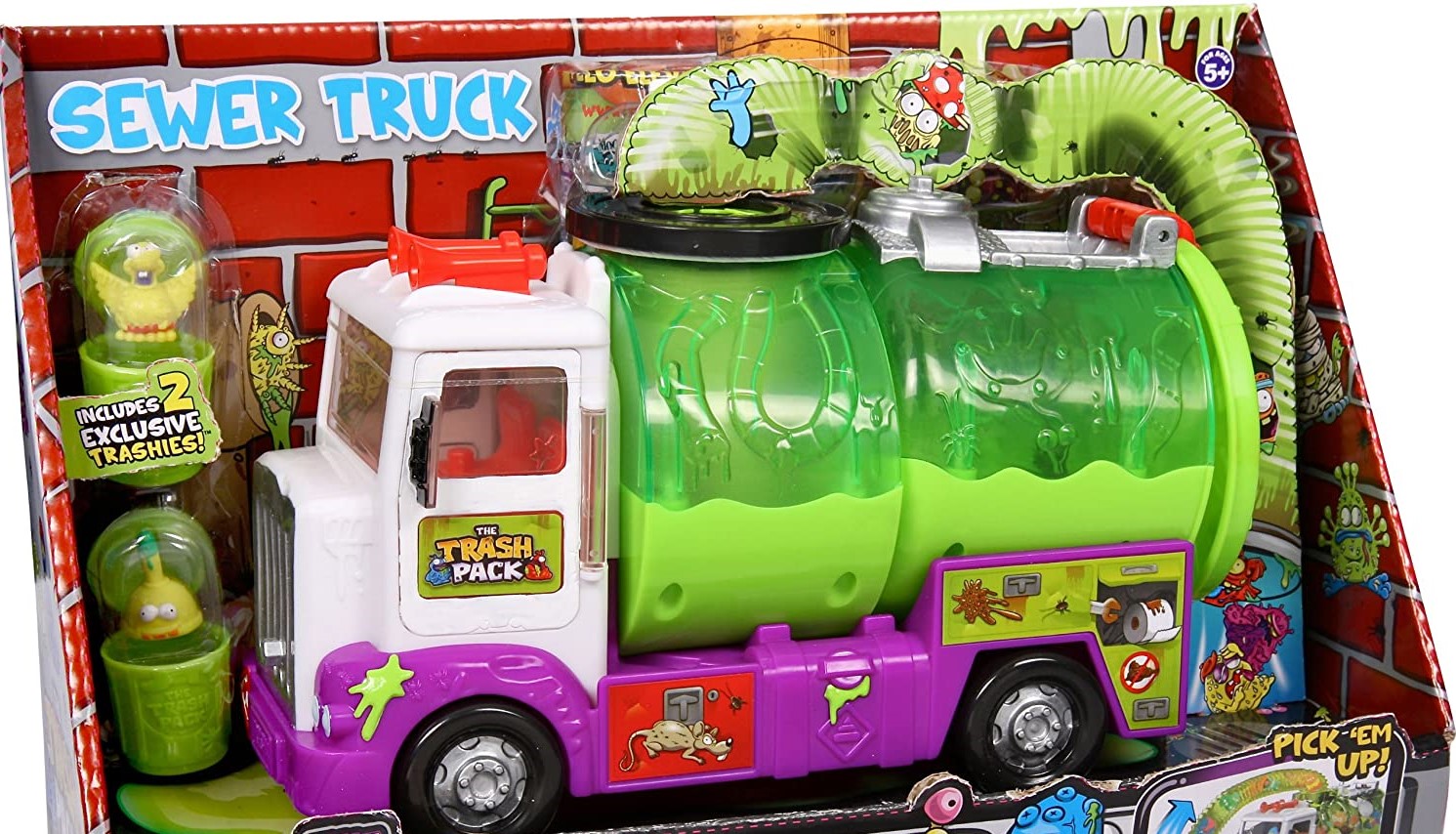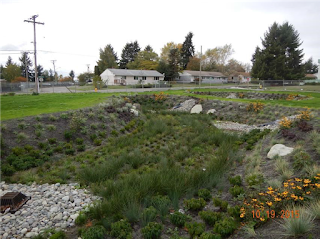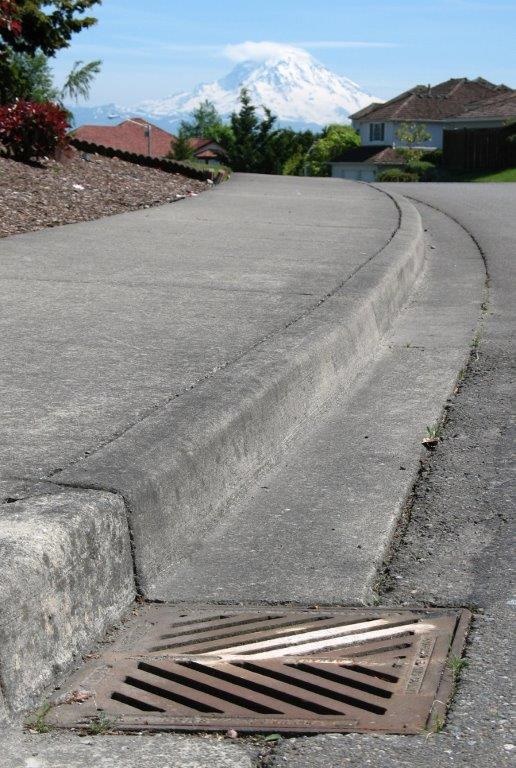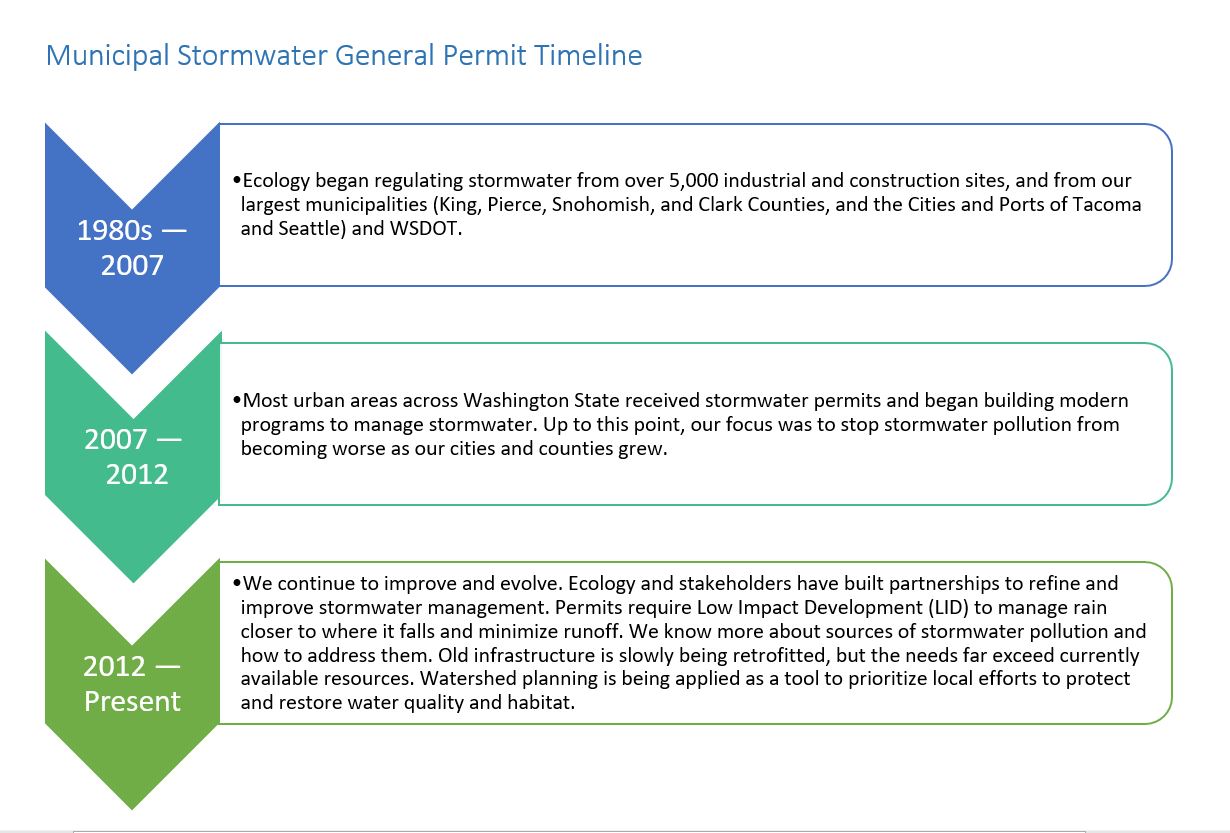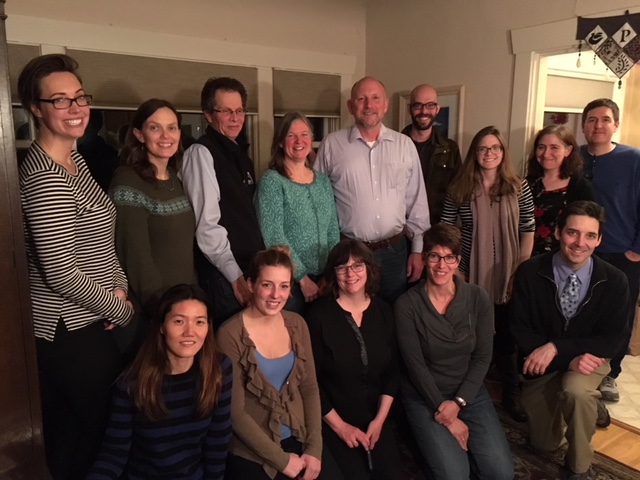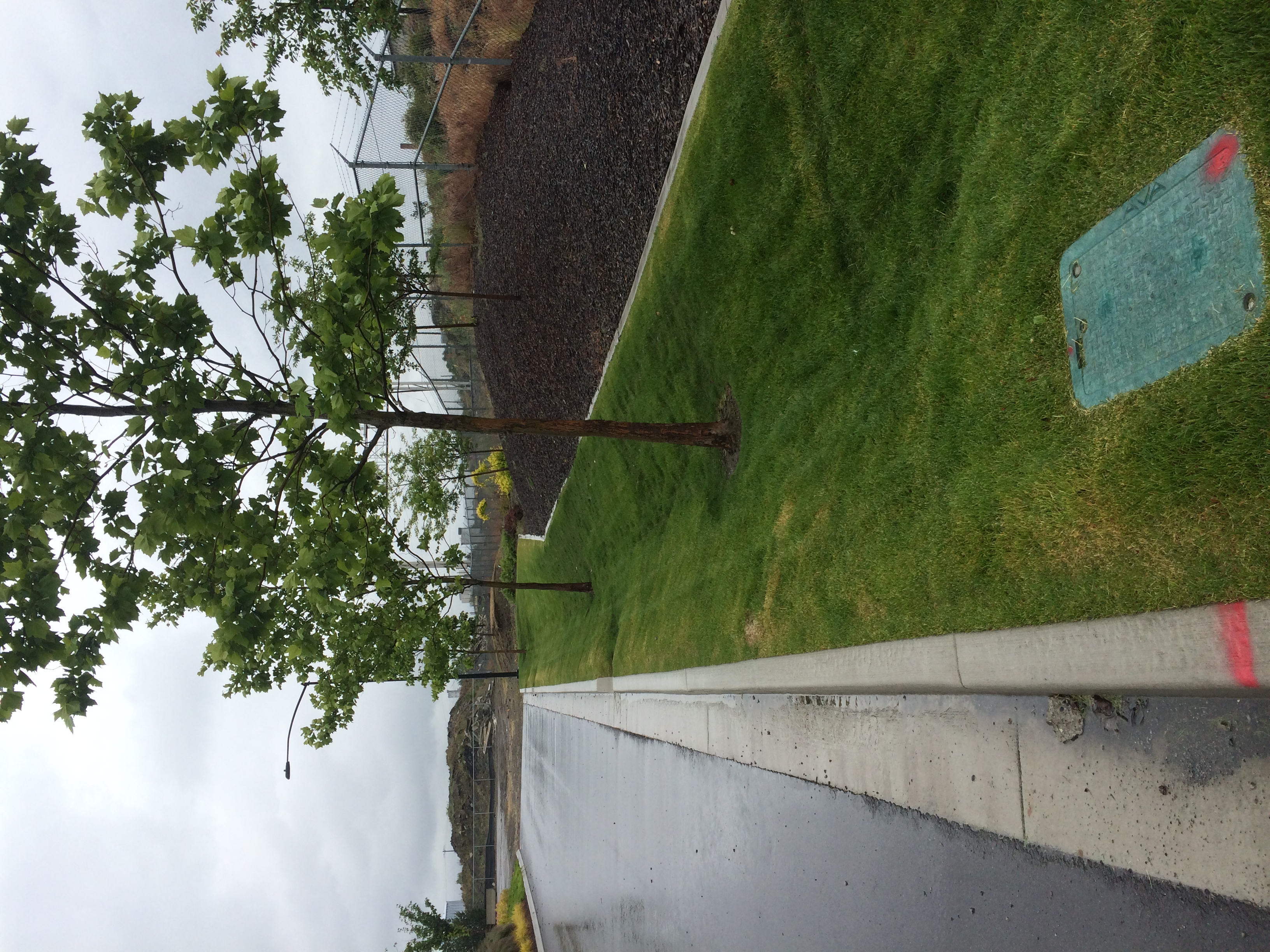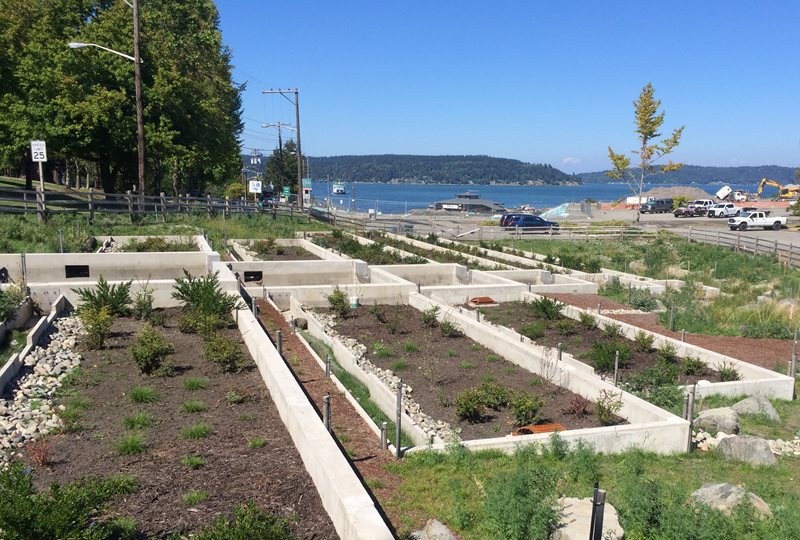
What looks like landscaping at Point Defiance is actually stormwater treatment.
Today, most 4th graders in Washington learn that when we cut down trees, add more pavement, and put up more buildings, we change the natural flow of water. In cities and towns, less rain is able to soak slowly into the ground, causing the water to run over the pavement faster while collecting pollution contaminating lakes, rivers, ocean, and Puget Sound — in other words, they learn about stormwater.
Vacuum trucks are a useful maintenance tool to clean out sewer systems.
As the state’s infrastructure was built, the focus was on flooding problems, not the stormwater pollution or habitat impacts. In the 1990s, the state started regulating stormwater that comes from city and county stormwater sewer systems. To help solve the pollution problem, we established a Municipal Stormwater Permit program. And now, not only does Washington lead the nation in municipal stormwater management, stormwater management is so mainstream you can even buy your kids a toy vacuum truck to play with!
In celebrating Ecology’s 50th anniversary, we're celebrating our municipal stormwater permit program — an excellent example of how hard work, innovation, partnership, and science can come together to help make Washington a better place to live and help the environment.
Why address stormwater?
We have permit programs for multiple types of stormwater, depending on the type of area or business — construction, industrial, sand and gravel, boatyards — but today we're talking specifically about our municipal stormwater permits. Polluted stormwater runoff is often carried through municipal separate stormwater sewer systems (MS4s) straight to our lakes, streams, and marine water bodies across Washington state. Unmanaged stormwater erodes habitat and carries sediment, oils, metals, nutrients, pesticides, bacteria, trash, and particles like tire rubber and microplastics straight into Washington’s waters.
Planted retention areas
The municipal stormwater permits require cities, counties, and the Washington State Dept. of Transportation to regulate and manage the stormwater from the urban landscape — through the development of comprehensive Stormwater Management Programs that are designed to prevent harmful pollution from being washed or dumped into the sewer systems. The permits' goals are to let rain soak into the ground where it lands, reduce stormwater pollution at its source, treat it, and control the volume and flow of water, so cleaner water goes into creeks, rivers, lakes, groundwater, and Puget Sound. The permits include guidance manuals that have science-based best management practices and require local jurisdictions to use a suite of actions and tools to reduce water pollution from stormwater. Cities and counties under the permit need to manage:
- Their MS4 systems — the streets and outfalls, stormwater flow control and treatment facilities.
- Pollution sources — accidental spills, intentional dumping, and maintenence of surfaces that could add pollution.
- Development practices — fixing past construction errors, ensuring current development practices preserve soil and trees as much as possible, to help stormwater soak into the ground as it would naturally.
Developing a new permit program
In the 1980s ,studies determined that some of the pollution in urban bays in Puget Sound and freshwater systems was coming from pollution in stormwater. That led us to develop the first Puget Sound Water Quality Management Plan in 1988, which included a number of stormwater action items.
The Clean Water Act and the Washington State Pollution Control Act required the EPA and subsequently the states to develop a permit program to manage stormwater from various sources — including stormwater from cities and counties.
It's hard to believe but much of the rain we get here in the Pacific Northwest runs through storm grates like this and eventually make it to Puget Sound. Photo credit Dan Smith, Federal Way
We focused on the largest communities first. By 1995, the largest local governments in Puget Sound were working to manage their stormwater and requiring developers to use Best Management Practices (BMPs) to prevent pollution. We called the first permit the Phase I Permit. It covered Seattle, Tacoma, and most of King, Snohomish, and Pierce counties. In 1999, we added Clark County to the Phase I Permit.
With the biggest population centers of the state under permit, we moved on to the next most populated parts of the state, or Phase II — which focused on smaller cities and counties and ways that they can manage their stormwater. We also knew that local governments needed more specific tools to use in creating and implementing their local stormwater programs; so, we got to work improving our guidance manuals. A small team at Ecology set out to develop the permits and guidance manuals, working with local governments to develop a unique permit program that would work for each community, have built-in flexibility, and be effective at preventing and managing stormwater pollution. We separated the Phase II permits into east and west because of the differences in climate. It was a big effort, and took from 2000 – 2007 to complete. And, this was before everyone was regularly using email, doing virtual presentations, or editing documents online.
“There were 111…local governments in Puget Sound and we drove, and sat, and had meetings with 89 of them," said Ann Wessel, Ecology’s first Phase I Municipal Stormwater Permit writer. “There were a couple that didn’t have phone lines, so we couldn’t get ahold of them by phone to have meetings and there were a couple that joined in other meetings.”
Rachel McCrea, Ecology’s water quality supervisor for the Northwest Region, shared her insights on what is was like to help build Washington’s municipal stormwater permit program and why she continues to enjoy working in stormwater.
Stormwater Permit Timeline
The people who got us here today
The 2017 Municiple Stormwater Team
Washington has a great stormwater program in part because we have great teams. We’d like to say thanks to a number of unsung stormwater heroes who helped start our program, many of whom are no longer at Ecology, but continue to inspire us to do our best work every day. When you think about the resources it takes to launch a critical, statewide permit program, you might envision a pretty big team. In reality, it fell to a handful of folks who relied on their technical expertise, relationship building, and commitment to the cause. Thank you to:
- Bill Moore, Washington’s Stormwater Policy Lead and champion for state funding assistance.
- Ann Wessel, Ecology’s first Phase I Permit writer; she worked with King, Pierce, Clark, and Snohomish counties and the cities and ports of Seattle and Tacoma to start managing their stormwater; and mentored the Phase II permit writers.
- Ed O’Brien, the lead author of Ecology’s Stormwater Management Manual for Western Washington and the engineer who later brought LID and Phase I watershed planning into the permit requirements.
- Karen Dinicola, the lead author of Ecology’s Stormwater Management Manual for Eastern Washington, the main architect of the SAM program, and later the co-author of the watershed planning guidance and Phase II requirements.
These stormwater leaders built a sound foundation for the regulation and management of municipal stormwater and propelled Washington’s permit program as a national model of how to do it well. We had the chance to catch up with Ann and Ed to reflect on their experiences and careers at Ecology. We’ve edited the conversation down and encourage you to give it a listen if you want more insights into what it was like to launch what has become a nationally-known permit program. During our conversation, Ed and Ann also expressed their appreciation for the stormwater experts in local government who worked with them through the permitting process. The local governments had, and still have, some true stormwater experts who work on the ground and continue to innovate better ways to approach this complicated problem. This partnership is what's made the state such a success.
A statewide program that is unique and effective
Deputy Director Heather Bartlett was impressed to learn that the municipal stormwater permits cover best practices for 'color runs' - an activity Bartlett enjoys with her family
Since the first permits were issued, we've continued to work with municipalities and stakeholders to refine and improve our permits.
Not everyone agrees with what should be in the permits, so our work can be contentious at times and we do our best to issue permits that are clear and effective.
During every five year permit cycle, a couple more jurisdictions get coverage under the permit due to population growth.
As the state's population continues to grow, our municipal stormwater permit program has continued to grow, evolve, and adapt over the years.
“Washington state and its residents place a high value on clean water, salmon, orcas, and our ability to play in the state's waters,” said Abbey Stockwell, Ecology’s Municipal Stormwater Senior Planner. “That puts us in a unique position to rely on a wealth of research, data, and support to drive innovation and effectiveness in the Municipal Stormwater Permit requirements.”
With funding from Ecology, this project in Spokane is now greener and providing cleaner stormwater
Here are a few of our innovations that make us national leaders in managing stormwater:
Funding: Our municipal stormwater program is unique in the amount of state funding that is passed through to local governments in the form of stormwater grants and loans. Since 2007, Ecology has provided over $400 million to local governments to address the impacts of urban runoff.
While nearly all permittees fund their core programs with local stormwater utility fees, Ecology's grant funds are used by permittees to train stormwater staff, inform business owners and community members about local stormwater issues, improve stormwater system maintenance, and provide other enhancements to their stormwater programs. Cities, counties, and ports also use this funding to build new stormwater facilities, such as rain gardens or created wetlands, to treat and manage urban runoff across the state.
Low-impact Development: The goal of Low Impact Development (LID) is to mimic the natural water retaining and filtering functions of the land as land is developed. Since the 2000's, stormwater managers have actively looked for better ways to control urban runoff than the retention and detention ponds of past decades.
Stormwater Action Monitoring (SAM): SAM is what you get when collaboration and science come together. Having effective Best Management Practices and monitoring stormwater to learn what approaches are the most effective at preventing and reducing impacts is a critical part of the municipal stormwater program in Washington. SAM was born out of municipalities coming to Ecology, looking for a different way to approach permit-required monitoring. Permittees have the option to pay into a pooled fund dedicated to SAM studies that occur region wide.
SAM focuses on studies that evaluate current practices and can span multiple years to address vexing long-term questions. SAM is answering questions about stormwater impacts on the environment and meaningful actions local stormwater managers, Ecology’s engineers, and permit writers can take increase the effectiveness of our efforts.
Stormwater Planning: Through research, we know implementing all of our requirements on a site-by-site basis is not enough to protect water quality and habitat, particularly small streams. Permittees are now required to do stormwater planning on a watershed-scale to look at future buildout conditions and help account for old projects and infrastructure that need retrofits to improve function.
Environmental Justice: Our most recent permit reissuance in July 2019 marked the first time environmental justice requirements and guidance were specifically included in an Ecology permit. We aim to improve awareness and be more inclusive to improve quality of life for those most affected by water quality impairments. Rian Sallee, Ecology’s Vancouver Field Office Manager, shared her reflections on the addition of environmental justice in the most recent permits.
Source Control for Existing Development: A Phase I permit program was recently expanded to the Western Washington Phase II Permit that works to prevent pollution from entering the system at its source. Through a proactive inspection program, permittees can help stop pollution from commercial and business activities through technical assistance and best management practices — such as having a plan and clean up materials for accidental spills.
What’s next
“The Municipal Stormwater Permits will remain a critical tool for preventing pollution from entering waterways," said Emma Trewhitt, Ecology’s Municipal Stormwater Planner. “The permits will actually become more effective over time as we continue to collect data and work with local stormwater experts and stakeholders ensure the requirements stay meaningful and relevant."
Communities don’t have to wait until they are under the permit to start addressing stormwater. No matter the size of a community, protecting trees and soil, allowing rain to soak into the ground, mapping your stormwater infrastructure, coordinating with neighboring communities in watershed planning and restoration activities, and doing outreach and education are great ways to get ahead of stormwater pollution. Our teams are happy to talk to any community that is looking to do proactive stormwater management work and wondering where to start.
“Just recently an employee of [USEPA] Region 10 went out of their way to tell me that Oregon is using Washington’s stormwater general permits as their guide in updating the stormwater permits in their state. And it just confirms that Washington is still a national leader in stormwater permits.” Rachel McCrea, Ecology’s water quality supervisor for the Northwest Region.
Thank you for following along on this trip down memory lane for municipal stormwater – we are proud of the program we have built in partnership with local governments and looking forward to continuing to lead the nation in stormwater management for the next 50 years!


